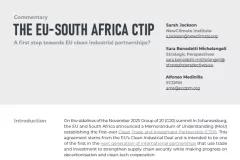Update 19 September 2024: The SBTi has invited stakeholders to provide feedback on its Scope 3 Discussion Paper through a survey, by 04 October 2024.
This document discloses NewClimate Institute’s response to the SBTi’s survey, along with an explanation of our interpretation and perspectives.
Today, the Science Based Targets initiative (SBTi) published two papers that indicate the future direction of its standards. The SBTi’s Scope 3 Discussion Paper sets out potential frameworks to encourage and enable companies to focus on critical emission sources through transition-specific alignment targets, ruling out the use of carbon credits from activities outside the value chain towards emission targets. The SBTi’s Carbon Credit Synthesis Report systematically assesses the evidence received in the call for evidence on EACs launched last October, clearly pointing to the ineffectiveness of carbon credits to meet corporate climate targets. These publications come after a controversial statement from the SBTi’s Board in April 2024 sparked an intense dispute over the potential role of offsetting for corporate climate targets, amidst reports of undue influence and conflicts of interest. The revision of the SBTi standards, the GHG Protocol and the development of an ISO net zero standard, may offer an encouraging pathway for the evolution of corporate climate accountability in 2024. The value of these initiatives will ultimately depend on the extent to which they are protected from undue influence and pressure.
What has the SBTi published today?
Today, following months of polarised wrangling over the potential role of offsetting to meet corporate climate targets, the SBTi has published two papers which shed light on the future trajectory of the initiative’s standards. SBTi’s Discussion Paper on Scope 3 Target Setting sets out a potential framework for a major revision of the existing SBTi Corporate Net Zero Standard. The framework outlines options to focus on key transitions necessary in each sector and reiterates SBTi’s position that carbon credits from activities outside the value chain may not be counted towards emission targets. This position is additionally reinforced by the findings of the second paper published by SBTi today, the Synthesis Report of the evidence on the effectiveness of carbon credits.
This indication of direction comes nearly four months after the SBTi’s Board of Trustees made its controversial and unilateral statement suggesting that the SBTi had decided to allow the use of carbon credits toward companies’ climate targets, causing outrage amongst SBTi’s own staff and sending shockwaves through the climate science and standard-setting community. Multiple reports from highly respected outlets including the Financial Times, Bloomberg, The Guardian and Follow The Money have reported on the potential role of private interests and undue influence on the SBTi Board’s statement, while the organisation’s staff reportedly called for its Board members to resign.
How does the SBTi propose to improve its near-term target setting framework?
Instead of succumbing to pressure to introduce unnuanced flexibility to its standards through carbon credits, the discussion paper published by SBTi today explores more direct and constructive solutions to addressing existing problems of corporate target setting.
The proposed framework would first require companies to identify and prioritise the most critical emission sources and related transitions within their sectors. The SBTi proposes to inform this prioritisation by assessing the inventory against the magnitude of the emission sources, activities in high-climate-impact sectors, and activities with high risk of emissions lock-in. For these prioritised emission sources and transitions, companies would need to commit to specific ‘alignment targets’ and ‘policies’ over the interim period on the way to their longer-term net zero targets. These near-term alignment targets would come either alongside or instead of aggregated interim GHG emission reduction targets. For example, vehicle manufacturers may need to set near-term targets framed in terms of the annual sales share of zero emission vehicles and the share of near-zero emission steel procured, rather than simply an emission reduction commitment compared to a base year. Companies’ longer-term net-zero targets would continue to be expressed in terms of aggregated GHG emission reductions.
This is not an entirely new approach: SBTi’s latest guidance for vehicle manufacturers published in March 2024 already allows vehicle manufacturers to be validated based on interim alignment targets expressed as a share of zero emission vehicles in annual sales, and validations in some sectors are contingent on the policy of halting deforestation.
How could the proposal for interim ‘alignment targets’ address current challenges in corporate climate target setting?
The proposal puts the spotlight on the necessary near-term actions and sector-specific transitions for companies, rather than focusing too much on aggregated GHG metrics that have proven particularly susceptible to obfuscation and creative accounting. Our analysis in three annual iterations of the Corporate Climate Responsibility Monitor indicated that current validations under SBTi’s standards do not always translate into meaningful changes to companies’ business models that address their most critical emission sources. The real meaning of companies’ emission reduction targets is often muddied by the exclusion of key emission sources, questionable baseline comparisons, reliance on carbon credits and other certificates, or reliance on technologies like CCUS and bioenergy in sectors where they are not appropriate.
The newly released proposal may also improve the scope coverage of near-term targets. The current SBTi Corporate Net Zero Standard requires companies to cover only 67% of their scope 3 emissions under their interim targets. Companies are entirely free to decide which emission sources to cover under their targets and may well exclude some of the most critical emission sources that require the most urgent attention. Under the newly proposed framework, we understand that companies should be required to set alignment targets and policies covering the most material and critical emission sources of their sector, which in most cases would lead to a set of targets covering far more than 67% of the scope 3 emission footprint.
This approach may address some of the genuine challenges that companies face with the current standards. By focusing on simplified and aggregated GHG metrics, the standards imply a common and uniform responsibility for companies to reduce the emissions of the sector they operate in. This does not sufficiently accommodate the differing circumstances and responsibilities of individual companies. The standards might be more accessible to large incumbent polluters than they are to sector innovators and disrupters, such as newly established manufacturers of renewable energy technologies or producers of plant-based foods, whose interim growth in production and related emissions may be beneficial for reducing the emissions of the sector overall. Targets expressed in terms of a company’s alignment with required transitions, rather than emission reductions against a base year, might better recognise and reward companies that enter the market with climate friendly solutions, encouraging rather than containing their growth.
While this may appear a promising framework in theory, the details of its implementation and communication will matter. It will not be straightforward to define watertight rules on how to identify the most critical emission sources and transitions that should be covered by specific alignment targets. Even if this can be achieved, setting 1.5°C-compatible targets for key sectoral transitions should not imply 1.5°C-compatibility of an entire business model: for example, an energy utility planning to phase out coal-fired power generation and transition from gas to hydrogen is not 1.5°C-aligned if the company also pivots its business model to derive a major portion of its revenue from fossil fuel extraction and trading. It is not realistic to expect standards developed by voluntary initiatives like the SBTi to foresee and cover all the potential current and future activities that companies may engage in. Against this backdrop, target validations from initiatives like the SBTi should not be interpreted as an all-encompassing approval of a company’s activities. The SBTi and other voluntary initiatives can take more responsibility to communicate clearly on what its validations mean, and what they do not mean.
What do the SBTi’s publications mean for the potential use of carbon credits towards scope 3 emission targets?
The second publication released by SBTi today – the Synthesis Report of the evidence on the effectiveness of carbon credits – clearly points to the ineffectiveness of carbon credits in delivering their intended mitigation outcomes. It also highlights the risks associated with the use of carbon credits for the purpose of offsetting by companies, and the challenges related to offsetting claims. The assessment notes a broad divergence of findings across the literature, but analyses this by categorising evidence into Tiers A and B (those with less risk of bias or irrelevance) and Tier C (those with higher risk of bias or irrelevance).
In line with this finding, SBTi’s Scope 3 discussion paper rules out the use of carbon credits from activities outside the value chain towards the achievement of emission reduction targets, or for credits to be used to partially compensate for the lack of target achievement.
The key problems and challenges of the current standards cannot be overcome through flexibility to use carbon credits. Improved standards need to encourage companies to put a distinct focus on addressing key transitions for their sector. In contrast, offsetting allowances could offer a cover up for the lack of progress on these key transitions. This may only weaken the ability of companies and third parties to understand and address these challenges that companies collectively face. Neither the exaggeration of progress, nor the substitution of meaningful action through carbon credits, are desirable. This is most clearly illustrated by the growing number of companies that are coming out vocally in their opposition to the use of carbon credits toward target fulfilment [1]. Companies that are making efforts to pursue robust climate change mitigation strategies face a serious competitive disadvantage, if the rules of the system allow for companies who continue business-as-usual to be validated on the same platform.
While SBTi’s discussion paper is clear in ruling out the use of carbon credits from activities outside the value chain, it refers to a potential use case option to allow the use of carbon credits from activities within the value chain for accounting purposes. The paper provides little information on what exactly the SBTi means by this option. In our understanding, this option would allow companies to use carbon credits to account for emission reductions projects from sources within the value chain, such as projects implemented by suppliers. However, such carbon credits traceable to activities within the value chain remain a poorly defined concept and the paper’s explanation does not provide any further clarity on the concept’s rationale in light of the general evidence on the ineffectiveness of carbon credits. Therefore, we do not understand why this would be a useful or practical option as part of the wider framework proposal, while we see that it would entail considerable risks.
Are commodity-specific certificates a realistic option to accelerate sector transitions, or a risky compromise?
Although SBTi’s latest publications explicitly rule out a role for counting carbon credits from activities outside the value chain towards companies’ target fulfilment, the paper does imply a potential role for expanding the use of commodity certificates. For example, environmental attribute certificates for low-carbon steel, cement, or other specific commodities might be used to claim emission reductions from the specific scope 3 emission sources which these commodities correspond to, just as certificates for renewable energy have already been used for years.
This approach – for example extensively discussed in the recent proposals of the Advanced and Indirect Mitigation (AIM) Platform – may appear to be advantageous in theory if it accelerates the development and deployment of nascent zero-emission technologies that companies may currently have limited direct access to. In practice, however, it remains unclear whether it is realistic to implement such a complex system at the speed necessary to spur transitions, while ensuring that the system design is strong enough to avoid creating more unintended loopholes and avenues for delayed climate action and potential greenwashing. After decades of experience with renewable electricity certificates, the continued exploitation of loopholes with market-based accounting for renewable electricity points to the enormous challenge to operationalise a system for multiple commodities. Consequently, any proposal for an expanded use of commodity certificates in the SBTi Corporate Net Zero Standard requires very careful consideration. Its integration in the revised standard should not be a premature compromise to placate external pressure.
How do we move forward from here?
The publication of SBTi’s discussion paper kicks off a consultation period which will run until mid-September. Meanwhile, a revision of the VCMI’s Scope 3 Flexibility claim proposal – effectively a proposal to allow for offsetting that runs counter to the direction set out in today’s SBTi publications and could seriously undermine companies’ climate targets – is expected to be published within the coming weeks.
The disputes encapsulated in the current crisis at the SBTi – due to the Board of Trustees’ controversial and unilateral statement to allow for offsetting – are not unique to this initiative. In parallel, a process for a major revision of the GHG Protocol is underway, while the International Standards Organisation (ISO) has begun a process to build on its 2022 Guidelines on Net Zero to develop a fully-fledged ISO standard. Many of the same actors and disputes – especially related to offsetting with carbon credits, accounting of renewable electricity procurement, and market-based accounting approaches for other commodities – are also visible within these processes.
These processes may offer an encouraging pathway for the evolution of corporate climate accountability. Initial indications show promise that the next generation of standards could overcome some of the legitimate barriers faced by companies to accelerate climate action, while also closing loopholes and increasing integrity. The value of these initiatives — and particularly SBTi’s ability to fulfil their purpose of “helping prevent the worst impacts of climate change and future-proof business growth” — will ultimately depend on the extent to which they are protected from undue influence and pressure to weaken the integrity of their standards.
[1] See for example statements from H&M Group, Telstra, Decathlon, Michelin and other companies.








